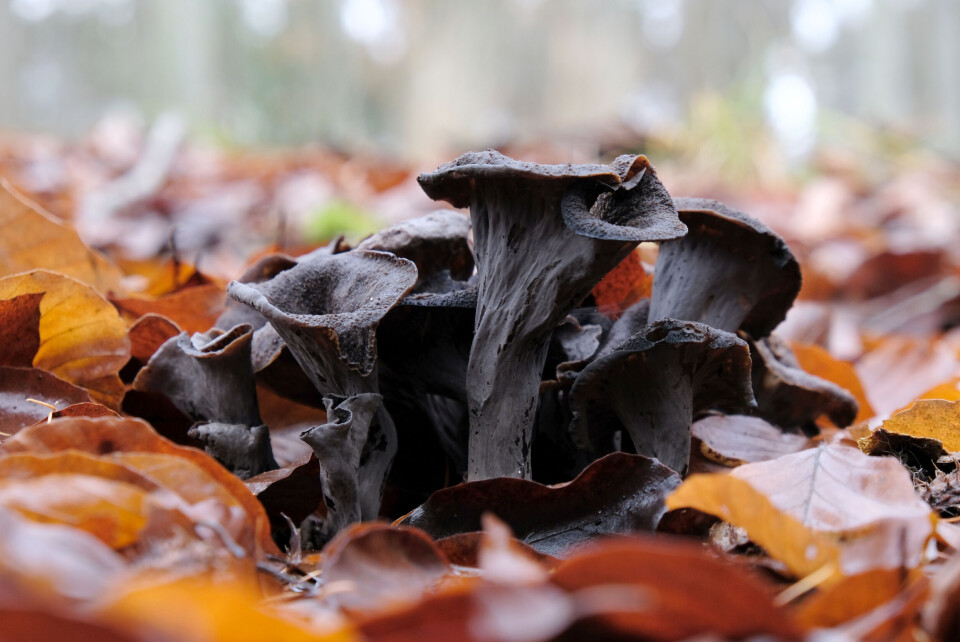-
Why Cadbury’s chocolate fingers are coming back to French supermarkets - at double the price
The biscuits disappeared from French supermarkets last year
-
Alert over health risks of eating wild asparagus in France
Close to 50 cases of poisoning from wild plant were recorded between 2010 and 2020
-
Which fruits, vegetables and fish are in season in France this April?
Strawberry season begins, compensating for end of winter vegetables
Top French chef champions ‘trumpet of death’ mushroom
Have you tried this tasty 'poor man's truffle'? Take care when foraging

The name might put many off but one chef is doing his bit to champion trompette de la mort mushrooms by making them a menu staple.
So-called for their sombre colour rather than any toxicity, the mushrooms have an “intense flavour” with notes of ground coffee, says Quentin Bourdy, who runs gourmet bistro Jacques a dit in Aveyron with his wife and fellow former Top Chef contestant Noémie Honiat.
Tasty ‘poor man’s truffle’
As well as trompettes de la mort, the restaurant features other foraged ingredients, including respounchous – a kind of wild asparagus, and poisonous when raw.
Trompettes de la mort can sometimes be tasted in bourguignons and patés, especially in the Dordogne, Lot or Aveyron.
Easy gathering and preparation make them a good initiation into the world of mushroom foraging and a tasty addition to a range of savoury sauces.
They are also known as the ‘poor man’s truffle’ as they can be used in much the same way, or ‘horn of plenty’ due to their tubular form: wide at the top and tapered at the bottom.
Read more: Adopt an oak tree in France and enjoy the truffles it produces
Read more: Black truffle from France sells for US$10,000 at online auction
Camouflaged on forest floor
The trompette has a trompe-l’oeil effect on the picker.
What first appears to be dead leaves on the forest floor can actually hold a supply of these delicacies.
The body is trumpet-shaped and hollow, grey in colour and smooth, forming a blackened, curled head.
Foraging tips
No knife is needed to gather these particular cantharellaceae.
They can be easily coaxed out of the undergrowth without uprooting the supporting mycelium.
September to November are the best months to forage for them and deciduous forests are often the choicest spots.
They tend to grow around oaks, elms and chestnut trees, making them an ideal picking partner to chestnuts.
How to check for poisonous varieties
It is always advisable to study a specialist foraging guide with clear illustrations or photos, such as the River Cottage Mushrooms Handbook or The Forager’s Calendar, both by John Wright.
Mr Bourdy suggests: “Go along with somebody who has been picking for many years. That way you will maximise your picking time and the quality of your finds.”
You can check your mushrooms with a pharmacy if you are not 100% sure you have the right variety.
One advantage of living in France is that they usually have a mycologist (or a pharmacist trained in mycology) available to advise.
Some pharmacies even organise walks to teach people the types of fungi that can be eaten and when they are in season.
Dry them to give luxurious flavour
Trompettes de la mort are better dried.
“I nearly always use them in their dehydrated state as this is when the taste is most pungent,” says Mr Bourdy.
He describes the “intense taste” as “luxurious, rich, with a caramelised flavour and notes of ground coffee and woodiness”.
Mr Bourdy adds: “There are a number of ways to use them but I find it best to add them directly to meat juices.
“The trompettes will rehydrate perfectly in the jus if left to simmer for at least half an hour.”
For the more adventurous, Mr Bourdy suggests deep-frying the mushrooms for a few seconds and using them as a crunchy garnish for white fish: “The contrast is visually quite stunning.”
Trompettes are best split in two, brushed out, and slow-dried until needed – the slower, the better, according to Mr Bourdy.
Important warning on mushroom foraging
It is vital to correctly identify mushrooms before attempting to eat them.
Read more: Toxic mushroom linked to high rates of nerve disease in south France
Read more: Wild mushrooms in France: Three deaths, 330 poisonings this year
Health and food safety agency Anses warns there were four deaths from misidentified mushrooms in France in 2021, and no fewer than 1,269 poisonings were recorded between July 1 and December 31 last year.
It is not just that some edible mushrooms look similar to toxic ones. Mushrooms in a bad condition can be a health hazard too.
The organisation also warns against relying on smartphone apps to help decide which are safe, insisting they can often be unreliable.
Related articles
Young French pastry chef says ‘love’ is key to perfect croissant
Michelin star chef makes Loire France’s sustainable eating capital
Meet Eugénie Brazier - France’s first six Michelin star chef
























